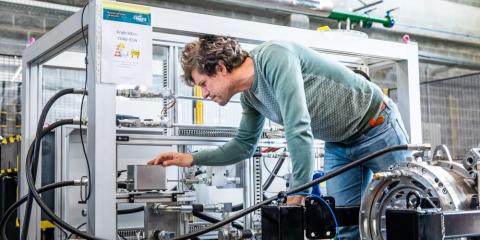Advanced cooling for powertrains

Driven by the current energy transition, there is an increasing focus on electric powertrains and engines. Making these increasingly versatile and efficient remains a key objective in the pursuit of a climate-neutral world. The cooling of the system is an important aspect of this, as power and efficiency are directly dependent on it. Flanders Make is therefore committed to optimising that cooling process as much as possible, both in an industrial context and for vehicles.
Cooling and lubrication with the same circuit
Electric power trains contain a number of components that generate heat, including an electric motor, and consequently also need cooling to maintain constant performance. The better we manage to cool the motor, the more power it can achieve. In addition, electric power trains also need oil to lubricate moving parts to keep them operating smoothly. Optimising cooling (and lubrication) is therefore interesting, because the right interventions in a powertrain can also improve its power density and efficiency.
We have worked with companies in the past, investigating various alternative cooling methods. This ongoing research looks at how the oil circuit that is already provided for lubrication can also be used for cooling. This allows to remove a separate cooling circuit (using e.g. water-glycol as coolant), which involves fewer components, energy consumption and costs. In addition, direct contact cooling techniques allow the (dielectric) oil to come into direct contact with the heated parts and cool them better, so power can be boosted for the engine with oil cooling. This innovative direct contact oil cooling thus increases power density, as wattage per kilogram is increased. This even up to 50%. Within these studies, we were able to apply for a patent for a specific solution that we developed here.
Simulations for cooling performance
The technology surrounding electric powertrains is evolving rapidly, which often makes it difficult for companies to choose the right approach for their system. In doing so, we take a systems approach, easy to use, where detail and system modelling can be linked automatically. These include the following developments:
- Validated detail models: We not only developed new concepts, but also worked on specific detailed models to correctly predict cooling performance and that for different types of cooling for multiple engines and power electronics. An example is our generic thermal models for electrical machines (EM-Therm) and power electronics (PE-Therm), which we deploy and tune to suit companies in B2B- and research projects with companies.
- Validated system HYPERTHERM toolbox: We also noticed that there is a need for simulation tools for companies to easily evaluate the benefits of these design choices for their system, so we developed a plug-in (our 'custom HYPERTHERM toolbox') for Simscape, a software package that is already commonly used for working out physical systems. Our add-in also allows the existing simulations to be extended to include different types of cooling that are not standardly available in existing commercial tools. This toolbox allows to reduce detail models per example of an engine (EM-therm or MotorCAD model) to a reduced system model. This allows companies to simulate how performant an innovative cooling method will work in a system quite early in the process and in a simple way. Furthermore, we also invested in test infrastructure for model validation of the above detail and system model toolboxes so that they can be deployed for and by companies.

Meanwhile, we are working hard with DANA, one of our research partners, to validate the results of the simulations with data from prototypes. This will allow us to further fine-tune the simulations in order to finalise the research by summer 2023. Then the system approach with accompanying EM & PE-therm detail models and the linked HYPERTHERM toolbox can also be used more widely in the ongoing energy transition.
Does that sound interesting? Then be sure to contact Stephan Schlimpert (project leader of the research project), and we will see how we can apply our modelling & validation approach to innovative cooling concepts in your drive system!